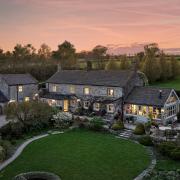Jo Haywood visits the birthplace of the Bronte sisters no, not Haworth

When Patrick Bronte preached from the pulpit at Bell Chapel, he wasn’t addressing the people of Haworth but their near neighbours in Thornton, a little over six miles to the south-east. He was vicar of St James’ Church – now commonly known as Bell Chapel or Bronte Bell Chapel – from 1815 to 1820, and his literary daughters, Charlotte, Emily and Anne, were all born in Market Street at the heart of the small village of Thornton to the west of Bradford.
Bell Chapel, which recently celebrated its 400th anniversary, is now lovingly cared for by the Old Bell Chapel Action Group, a band of like-minded volunteers with the skills and enthusiasm to preserve and enhance the church and its surrounding graveyard. The action group has installed an information board and created a wilderness corner, a recycling bay and a bird nesting area. Visitors can also see the remains of the original building directly opposite the modern-day church on Thornton Road.
Travel a little further west along the village’s main thoroughfare and you’ll soon come to South Square, a striking visual arts and heritage resource centre housed in a Grade II listed building originally created as a courtyard of stonemasons’ cottages in 1832. Thornton & Allerton Community Association stepped in to save the buildings from dereliction in 1982 and set about restoring them in partnership with Bradford Council and the Manpower Services Commission. Three decades on, the square is now a sustainable enterprise, home to productive workshops, a fine art framer, craft shop, cafe and the main South Square Gallery, a grassroots quartet of exhibition spaces committed to providing a professional and supportive resource for artists and emerging curators.
‘Thornton has always had a strong artistic community,’ said David Knowles, artistic programme manager. ‘I think writers and artists are attracted to the village because it’s close to Bradford city centre but retains a strong rural appeal. Over the years, we’ve managed to build quite a reputation locally, regionally and nationally by staging exhibitions of adventurous, experimental new work in our main gallery, drawing in visitors from around the country, while using our community space for more traditional local work.’
Distinguished artist Conrad Atkinson, whose work has been shown all over the world including the Tate in London and the National Gallery in Washington, became patron of South Square after a highly successful solo exhibition in 2011.
‘They collaborated creatively and curated the complex pieces with such enthusiasm and care that much of the works gained more meaning and resonance than they had in other venues in Europe and New York,’ he said. ‘The success of the show was due to the efforts of this unique team and its fertile relationship both with art and its practice and its integrity with its audience.’
South Square runs a pioneering curatorial internship programme for graduates, which gives fledgling curators the chance to stage exhibitions under the guidance of experienced mentors. It’s also home to Thornton Antiquarian Society’s archive of local history material, which has been relocated as part of the Stone Heritage Project. ‘This is about us paying our dues to the local community,’ said David. ‘We don’t want to get too big for our boots, concentrating on drawing in audiences from outside the district at the expense of the people here in Thornton.
‘We have a dedicated community room, where we hold numerous exhibitions and workshops for local schools, and we continually work hard to keep the village engaged in what we’re doing.’
South Square and Bell Chapel are integral parts of this extremely well-preserved Pennine village, adding an extra dimension of interest to its combination of modern homes and hillside terraces of stone-built houses with stone-flagged roofs.
Thornton Viaduct, which spans the Pinch Beck valley, is the cherry on this already architecturally interesting cake, its 20 arches snaking stealthily along for 270 metres to the south of the village near Headley Golf Club. It was built to carry the GNR line from Queensbury to Keighley, opening for passengers in 1878 and closing in 1955. It remained open to goods until the 1960s when it was finally shut down and the tracks pulled up.
But that’s not the end of the story. The Grade II listed viaduct was reopened in 2009 as part of the Great Northern Railway Trail, allowing visitors to follow its undulating S shape, built to follow the natural contours of the valley, and see the remains of the original goods platform and retaining wall, which are now part of Thornton Primary School.
The original five metre-long platform sign, which once heralded the arrival of rail-bound visitors with the word Thornton in large concrete letters, was removed long ago but can still be seen on display at Bradford Industrial Museum in Eccleshill.
For more information about Bell Chapel and South Square in Thornton, visit brontebellchapel.co.uk or southsquarecentre.co.uk.



























